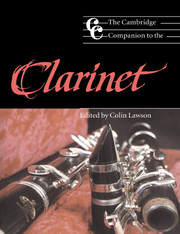Book contents
- Frontmatter
- 1 Single reeds before 1750
- 2 The development of the clarinet
- 3 The clarinet family
- 4 The development of the clarinet repertoire
- 5 Players and composers
- 6 The mechanics of playing the clarinet
- 7 Teaching the clarinet
- 8 Playing historical clarinets
- 9 The professional clarinettist
- 10 The contemporary clarinet
- 11 The clarinet in jazz
- 12 The clarinet on record
- Notes
- Appendices
- Select bibliography
- Index
11 - The clarinet in jazz
Published online by Cambridge University Press: 28 September 2011
- Frontmatter
- 1 Single reeds before 1750
- 2 The development of the clarinet
- 3 The clarinet family
- 4 The development of the clarinet repertoire
- 5 Players and composers
- 6 The mechanics of playing the clarinet
- 7 Teaching the clarinet
- 8 Playing historical clarinets
- 9 The professional clarinettist
- 10 The contemporary clarinet
- 11 The clarinet in jazz
- 12 The clarinet on record
- Notes
- Appendices
- Select bibliography
- Index
Summary
Introduction
Listen to almost any performance from the first decade of recorded jazz and you will hear the sound of the clarinet. Whether you choose to listen to the Original Dixieland Jazz Band (ODJB), the King Oliver/Louis Armstrong recordings or Jelly Roll Morton's Red Hot Peppers, you will hear every ensemble topped by upper-register clarinet, playing in harmony above the melody.
All the evidence about the origins of jazz points to the music having developed from vocal performances. Undoubtedly field hollers, work songs, religious music and the famous post-1817 New Orleans Congo Square dances were all part of the picture, as far as vocal music was concerned. After the end of the Civil War in 1865 the New Orleans blacks were able gradually to acquire the instruments of the military band, including the clarinet. Military (marching) bands were important in all-French settlements, and in New Orleans most of the early jazz players started their careers in such wind bands, playing marches, polkas, quadrilles and so on. From these two sources – the vocal folk/dance music and the marching band – it is quite easy to understand how the five- or six-piece jazz bands evolved. Of course the evolution of jazz included the influence of many other musical styles, ranging from Ragtime and Klezmer to the Chopin waltzes from which stride piano (with its ‘striding’ left hand of a bass note on beats 1 and 3 and a chord on beats 2 and 4) was probably derived.
- Type
- Chapter
- Information
- The Cambridge Companion to the Clarinet , pp. 184 - 198Publisher: Cambridge University PressPrint publication year: 1995

